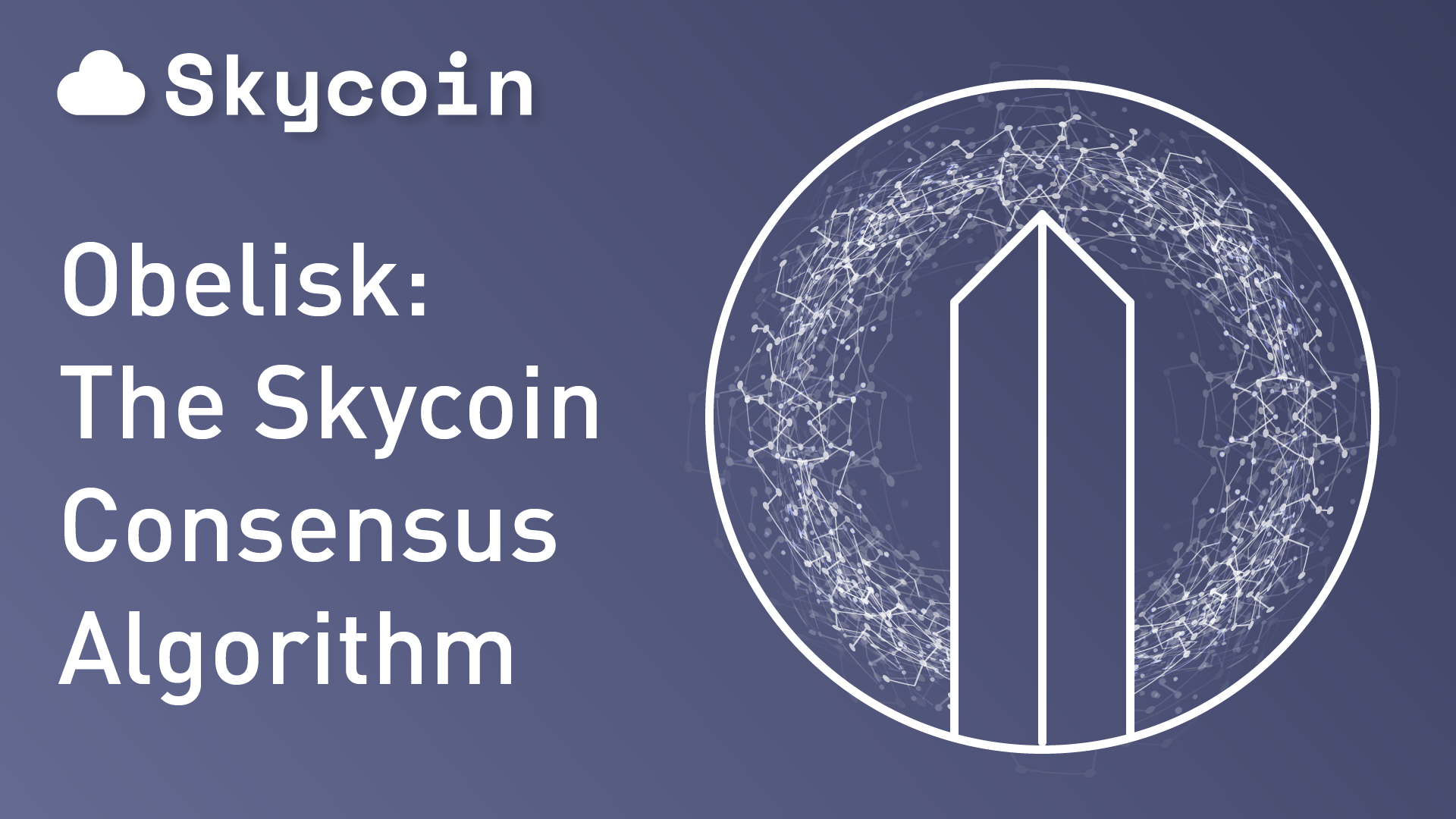 Back to list
Back to list

Obelisk: Skycoin Consensus Algorithm | Information Pages
Consensus highlights
Why consensus
Skycoin Consensus Algorithm (“Obelisk”) synchronizes the state of Skycoin blockchain across all the network nodes. This results in consistent accounting, i.e. when calculating coin balance for a given public key (or address) yields same value at each node that performed the calculation.
High scalability and low-energy consumption
By design, the algorithm is a scalable and computationally-inexpensive alternative to proof-of-work, therefore both the consensus algorithm and block-making can be run on a budget hardware that have low price and low energy consumption, thus making the cryptocurrency network more robust to possible centralization attempts (i.e. via node being affordable to general public).
Robust to coordinated attacks
Our Consensus Algorithm (i) converges fast, (ii) requires minimal network traffic, and (iii) can withstand a large-scale coordinated attack by a well-organized network of malicious nodes. The algorithm is non-iterative, fast, can be run on a sparse network with only nearest-neighbor connectivity (e.g. on Mesh Network), and works well in the presence of cycles in the connectivity graph (i.e. DAG-type connectivity is not required).
The “51-percent Attack”
In a limited sense, the base version of the Algorithm can be subject to this attack. Specifically, when the modified or malicious nodes who are in majority broadcast a protocol-compliant and UTXO-compliant candidate block, such block wins the consensus. However, a block with any sort of non-compliance is dropped by the (unmodified) Algorithm before the block gets a chance to participate in consensus trial.
Consensus nodes can optionally utilize a Web-of-Trust concept in such a way that consensus-related messages that come from unknown nodes (i.e. signed by untrusted public keys) are ignored.
When Web-of-Trust mode is enabled, starting a very large number of malicious consensus nodes in order to (a) cause blockchain fork or (b) disrupt the consensus process would have little effect, unless a vast majority of Web-of-Trust members unwittingly include those malicious nodes into their local lists of trusted nodes.
Hidden IP addresses
The nodes are addressed by their cryptographic public key. Node’s IP address is only known to the nodes to which it is connected directly.
Independence of clock synchronization
The Algorithm does not use “wall clock” (i.e. calendar date/time). Instead, block sequence numbers that are extracted from validated consensus- and blockchain- related messages are used to calculate node’s internal time. This can be informally called “block clock”.
Two type of nodes: Consensus and Block-making
A consensus node receives its input from one or more block-making nodes. The algorithms for consensus and block-making are separate, yet they both operate on same data-structures. We mention block-making where it helps understanding the Consensus Algorithm and how it integrates with the rest of the system.
Both type of nodes always performs authorship verification and fraud detection of incoming date. Fraudulent or invalid messages are detected, dropped and never propagated; peer nodes engaged in suspicious activities are disconnected from, and their public keys are banned.
How Skycoin Consensus Algorithm works
For exposition purposes only, the following description assumes that (i) each node is both block-maker and consensus participant, and (ii) consensus-related messages generated by non-trusted nodes are accepted, i.e. no filtering based on web-of-trust is performed. A full implementation (i.e. without these simplifying assumptions) will be available in Skycoin GitHub repository. For simulation results and a detailed, diagrammatic example of one consensus trial, see [1]. A simulation of a network with trust relationship, although using a different than Skycoin algorithm, can be found in [2]. The description of Skycoin Consensus Algorithm follows.
Block-making. Each block-making node collects new transactions, verifies them against the UTXO of the desired sequence number, packages the compliant transactions into a new block, and broadcasts the block to the network.
Collecting blocks. Each consensus node collects the blocks generated by block-makers, and puts them into a container (separate from blockchain) keyed by block’s sequence number.
Selecting winning block. Each consensus node, upon receiving a sufficiently large number1 of candidate blocks or upon meeting other criteria, finds the block that was made by the largest number of block-makers. Ties are resolved deterministically. Such block is labeled “local winner”2 and is appended to the local blockchain. The key-value pair corresponding to the block sequence number of the local winner is deleted, thus reclaiming storage. Hash code of local winner is broadcast/announced.
Verification step. Each node keep statistics on local winners reported by other nodes. When local winners have been reported by all or most of the nodes3, the node determines the global winner for the particular sequence number. If the global winner is the local winner, then the node continues to function as above. Otherwise the nodes decides, based on external data and local logs, between (a) re-synchronizing itself with the network or (b) dropping from participating in consensus and/or block-making or © keeping its blockchain and requesting an emergency stop.
References
[1] johnstuartmill et al. A Distributed Consensus Algorithm for Cryptocurrency Networks. https://github.com/skycoin/whitepapers/blob/master/whitepaper_skycoin_consensus_v01_jsm.pdf 2016
[2] Houwu Chen and Jiwu Shu. Sky: an Opinion Dynamics Framework and Model for Consensus over P2P Network. https://github.com/skycoin/whitepapers/blob/master/Sky-%20Opinion%20Dynamics%20Based%20Consensus%20for%20P2P%20Network%20with%20Trust%20Relationships.pdf 201?
Read more:
- This is a configurable parameter of in the Algorithm. ↩
Under certain ideal conditions, local winners (for a given block sequence number) are all the same, i.e. include identical set of transactions. The difference arises due to network latency, high frequency of transactions, out-of-sequence message delivery, message loss, malfunctioning or malicious nodes etc.
↩This number can be determined, for example, by asking trusted nodes to report public keys of their trusted nodes, recursively.
↩

 Telegram
Telegram